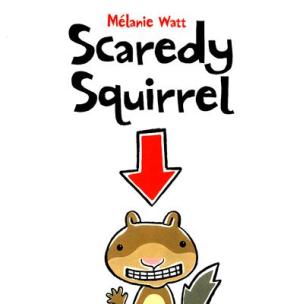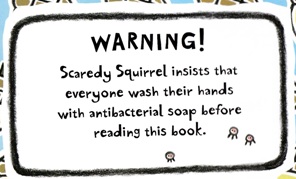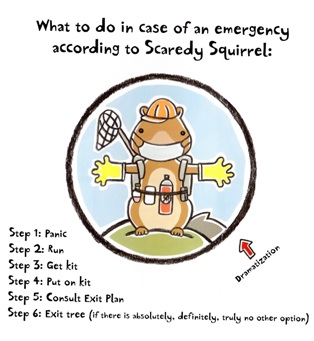In my last post, I discussed how, thanks to the picture book Chester, my daughter became a big time fan of Mélanie Watt, a seriously talented author-illustrator from Quebec. The hook of Chester is that a the title character, an ego-driven fluffy cat, absconds with a red marker and starts editing the book to favor himself, which kicks off a minor war between Chester and the book’s author, Mélanie Watt. It’s a nice slice of high-concept fun that turned Watt into a minor celebrity in our house and permanently placed the author on my daughter’s book-finding radar. We now know, when we hit the library or a bookstore, if we encounter a Mélanie Watt book, my daughter is going to latch onto it like an alien facehugger.
With that in mind, it was probably inevitable that my daughter would discover Scaredy Squirrel one day, another picture book series by Watt and the literary creation that she’s probably best known for. We actually first encountered Scaredy Squirrel at the Beach, the third Scaredy book, at our local library – “Dad! DAD! Mélanie Watt’s name is on this book, Dad!” – and it got such a big reaction at home that we quickly knew that we’d eventually be reading the entire series.
And I have to say reading Scaredy Squirrel books is a pleasure, particularly for adult readers. Because they’re funny. Really funny and they’re a total blast to read aloud. Every adult – parent, relative, friend – who has sat down with my daughter and read one of her Scaredy Squirrel books has loved the experience and asked for more. In fact, when I first launched this blog, my awesome sister-in-law, Erin, immediately sent me an email – subject line “me want scaredy squirrel!” – asking me when was I going to write about Scaredy Squirrel. (Hey Erin, the answer is “now.”)
There are five Scaredy books so far – Scaredy Squirrel, Scaredy Squirrel Makes a Friend, Scaredy Squirrel at the Beach, Scaredy Squirrel at Night, and Scaredy Squirrel Has a Birthday Party. We’ve read all of them, except for Scaredy Squirrel at Night, and have seriously enjoyed them all.
Scaredy Squirrel as a character is simple yet complex. He’s a squirrel with a laundry list of phobias, anxieties, and unbreakable daily routines. To quote Scaredy’s prologue in the first book (these prologues are the only place where the squirrel speaks in first-person): “I NEVER leave my nut tree. It’s way too dangerous out there. I could encounter germs, poison ivy, or sharks. If danger comes along, I’m prepared. I have antibacterial soap, Band-Aids, and a parachute.” And, in each book, Scaredy is confronted with some normal social situation – leaving home, going to the beach, trying to make friends – and we get to watch while Scaredy goes to absurd lengths to remove all variables or sense of risk from each situation, which, as we all know, is totally impossible.
I think Scaredy Squirrel works so well because it does an amazing job presenting the inherent humor of social anxiety in a way that both parents and kids appreciate. Everyone, old and young, knows someone who’s obsessed with de-sanitizing their hands or who eats the same exact lunch every day, and Scaredy Squirrel acts as a great proxy for those familiar personality quirks. Watt doesn’t mock Scaredy Squirrel’s phobias and anxieties, but she’s more than happy to show the ridiculous lengths he’ll go to in order to remain in his comfort zone. We get these wonderful checklists of Scaredy’s daily routine, we get breakdowns of all of the items in his various “emergency kits,” we get diagrams of his potential escape routes – it’s hysterical. It’s like watching someone put together a 75-slide PowerPoint deck detailing how they’re going to tie their shoes or walk to the mailbox.
In my experience, kids love these sections because they get to revel in Scaredy’s sheer level of hysterical panic about things they do every day with no problem. Chances are – when your kid walks down the street, they’re not worried about encounters with tarantulas, green Martians, sharks, germs, or Godzilla. (If they are, seriously, buy them this book now.) And I think adults love the way in which Watt presents Scaredy’s anxieties. Watt comes from a graphic design background and the layout of her pages – with Scaredy’s diagrams, inventories, and checklists broken down with individual icons that represent his fears – is a triumph of design. Scaredy’s breakdowns actually look like beautiful pieces of corporate design work, like emergency instructions that you might see hanging in the offices of Starbucks or Apple, which again, just makes their sheer ridiculousness all the more entertaining for adult readers. Scaredy Squirrel is a wonderfully designed creation – clean, clear, accessible – and the squirrel himself is, admittedly, extremely cute.
But, again, I want to make clear that Watt never mocks or judges Scaredy for being afraid. Instead, she just lets the reader draw their own conclusion – “Doesn’t that seem like a bit much for just going to the beach?” – and then concludes each book by demonstrating how freeing and fun it can be when Scaredy does eventually find himself outside of his comfort zone. I think the structure of the Scaredy Squirrel books is actually a very subtle and effective way to broach the subject of fears and anxieties with young readers. At the end of each book, Scaredy hasn’t changed as an individual – he’s still nervous and routine-driven – but he’s definitely made a small advance in expanding his horizons and experiencing the world a tiny bit more.
And, personally, I think that’s a much more effective way of realistically talking to kids about anxiety than presenting them with some contrived fable where the lead character takes one risk, gets rewarded, and then becomes suddenly fearless for the rest of their life. How realistic is that? No kid, who’s nervous about school or the dark or whatever, is suddenly going to encounter some deus ex machina that’s going to instantly chase their fears away for good. And they shouldn’t be made to feel strange because they haven’t found that non-existent “cure for all fears” yet. Scaredy Squirrel is always going be scared of things, but Watt’s books are all about how Scaredy finds ways to enjoy his life more after he takes small, accomplishable steps to confront his fears. I think that’s a fantastic message for kids.
And did I mention that the books are crazy funny? Because I think I just got a bit serious there and I don’t want you to think that the Scaredy books are just for kids with anxiety issues. These are funny, funny books – the squirrel has a contingency plan for dealing with GODZILLA, for Pete’s sake – that are beautiful to look at and a hoot to read. I can’t recommend them enough.
HOWEVER…
… I hate to mention this, but I kind of have to. Scaredy Squirrel has become famous enough that there is now an animated Scaredy Squirrel show airing on Cartoon Network. It was originally a Canadian produced show that has been picked up to air in the U.S. And, while I’m glad that enough people have embraced the character to justify a TV adaptation…. man oh man, do I hate the Scaredy Squirrel cartoon.
Here’s a clip so you can see what I’m talking about:
http://www.youtube.com/watch?v=WEeAdATxxKY
The opening credit sequence is actually the best part of the show. But the rest of it… it’s really “Scaredy Squirrel” in name only. It doesn’t resemble Mélanie Watt’s book AT ALL, in any way – from the design of the characters to the kinds of stories it tells. The Scaredy Squirrel on TV doesn’t look like Watt’s Scaredy in the slightest. In fact, in the few episodes I’ve watched, the whole thing just seems like a cheap knock-off of Spongebob Squarepants. Just like Mr. Squarepants, Scaredy now lives in a city, works a menial job that he takes ridiculous pride in, has an idiot best friend, and is more obsessive-compulsive and odd than “scared.” The tone of the show is frenetic and jumpy, which really clashes with the clean, organized chaos that Watt presents in the books.
Is this just me being an angry old man? Possibly. But, after my daughter, the huge Mélanie Watt fan who was OVER THE MOON about the idea of a Scaredy Squirrel cartoon, watched two episodes of the show on-demand, she turned to me and asked, “Can we watch something else? I don’t like it.”
BUT don’t let that anti-cartoon screed turn you off the Scaredy Squirrel books. They’re way, way good.
Now, originally, this post was going to cover Scaredy Squirrel and a few other Mélanie Watt titles that we’ve encountered so far, but I think Scaredy is enough for one post on his own. So, come back tomorrow for “In Praise of Mélanie Watt – Part Three”, in which we talk about Watt’s picture books You’re Finally Here and Leon the Chameleon.
THE DETAILS ON SCAREDY SQUIRREL:
AGE RANGE: Four and up, but, like Chester, my daughter found it when she was three and loved it. For kids younger than three, there is a lot of text, some of it small, on many of the pages, particularly the ones with Scaredy’s diagrams, so it might be a little hard for younger eyes to follow along.
PAGE COUNT: 42 pages
AUTHOR WEB SITE: Mélanie Watt is from Quebec, so her official website is in English and French. The site is pretty sparse – almost strangely so – but you can find some good information there. A large majority of Watt’s works have been published by Kids Can Press, so you can find more information on her works at their site.
BUY IT, BORROW IT, OR FORGET IT?: I say buy it. The first Scaredy book is in paperback and is pretty cheap. And, if your kid digs it, you’ve got four more titles you can grab later or at the library.
IF YOU LIKED SCAREDY SQUIRREL, YOU MIGHT ALSO LIKE:
- The One and Only Marigold by Florence Parry Heide, illustrated by Jill McElmurry – I wrote a long ode to The One and Only Marigold back in October, but let me explain why I think it’s a good choice for readers who like Scaredy Squirrel. I think the knee-jerk assumption is that, if you’re trying to recommend books that are “like” Scaredy Squirrel, you’re mostly going to be encountering books like It’s OK to Be Different or The Berenstain Bears In The Dark – books about fears and social anxieties. And I get that. But, for me, Scaredy Squirrel is almost just as much about a lead character with a very, very definite world view who goes to elaborate lengths to do things EXACTLY how they want them to be done – no matter what the outside world thinks. And, in that way, I think The One and Only Marigold is a great spiritual cousin to Scaredy Squirrel.
- Wemberly Worried by Kevin Henkes – However, it still does make sense to find some readlike suggestions for Scaredy Squirrel that DO cover a child’s tendency to worry, and Kevin Henkes’ Wemberly Worried is a stellar choice in that regard. Henkes, whom you might know from Lilly’s Purple Plastic Purse, tells a great tale of a young girl mouse who worries about almost every aspect of going to nursery school – the breadth of her concerns rivals Scaredy’s – until she actually arrives there and realizes that she might find some kindred spirits on the playground. A clever, gentle gem.
- Diary of a Worm by Doreen Cronin, illustrated by Harry Bliss – The slimy lead character of Cronin’s Diary of a Worm doesn’t have Scaredy’s issues with worrying or tendency to obsess, but there’s just something about the fantastic voice of this young worm keeping a diary of his daily events that reminds me of the perceptive, laugh-out-loud humor of the Scaredy books. Watt and Cronin are both extremely skilled at getting into the minds of young kids and, through their animal proxies, voicing their idiosyncratic concerns.



{ 0 comments… add one now }